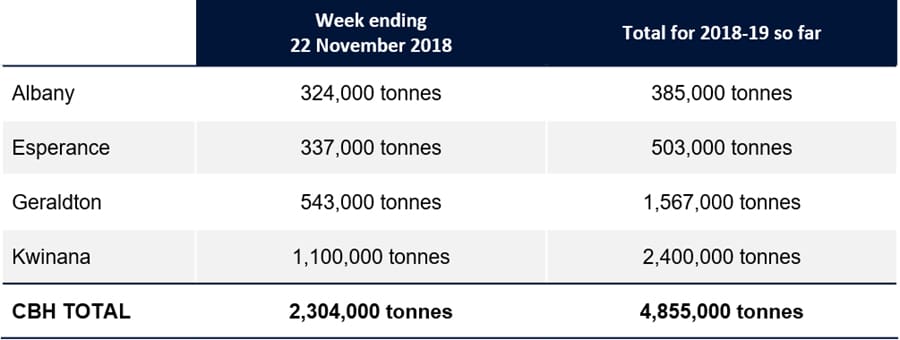GRAIN received from Western Australia’s harvest has more than doubled in the past week with receivals of 2.3 million tonnes (Mt) taking its intake to date to 4.86Mt, or 32 per cent of expected deliveries, according to bulk handler CBH Group’s latest harvest report.

Table 1: CBH Group receivals for the Western Australian harvest to date, and for the week to November 23. Image: CBH Group
This is slightly below the harvest point reached in last year’s harvest, when just over 5Mt had been delivered.
“The first few weeks of harvest have definitely been a little patchy with wet and stormy weather holding up progress in several areas,” CBH general manager operations David Capper said.
In contrast to the slower start that the Albany and Esperance zones have had, Geraldton zone has received around 65pc of its estimated tonnage already, with several sites coming close to breaking records for receivals.
“In some areas, we are seeing better-than-expected yields, which is promising for a great final harvest result.”
China impact
As a result of the Chinese anti-dumping investigation announcement, CBH has reported that barley values fell by around $30/t during this week as the market awaited further information on the announcement.
This resulted in some growers selling directly off the header, and prices to growers for barley today were around $300/t free in store (FIS).
CBH Group said it was doing everything it could to work cooperatively with the Australian grain industry, the Australian Department of Foreign Affairs, and the Ministry of Commerce of the People’s Republic of China to ensure a positive outcome for Australia’s grain-trading relationship with China.
In wheat, later harvesting has created some challenges, as the trade looked to cover some of its early shipment requirements.
This has seen the trade paying a premium to growers for specific grades for early transfer to ensure vessels are shipped within their contract period.
However, for standard grades like APW1, the market has remained relatively flat this week with a $5-7/t range in pricing around the A$340s per tonne FIS.
Domestic and international trade interest in canola has continued, and CBH has reported reasonably active grower selling, with the market staying steady at $573-575/t FIS.
Around the zones
Albany
The Albany zone is still having a much slower start to harvest than last year with 385,000t received so far, around 40pc less than the same time in 2017.
“Delays to harvest are once again due to continuing poor weather conditions in the zone,” Albany zone manager Greg Thornton said, adding that recent rain was not expected to have had an impact on quality at this stage.
The majority of Albany zone’s receivals have continued to be barley, with 330,000 tonnes received and a good percentage of this making malt grades.
Additional Planet segregations have been introduced to cater for demand.
The zone has received 45,000t, and was now starting to see wheat deliveries in northern areas.
Esperance
The Esperance zone has also been experiencing harvest delays due to poor weather.
“Late last week, we started to see some good tonnages being delivered, but scattered showers again this week have slowed things down again,” Esperance zone manager, Mick Daw, said.
Mr Daw said most of the zone’s canola has now been harvested, and growers were now moving on to barley and wheat.
Geraldton
The Geraldton has received 543,000t of grain in the week to today to lift its receivals to more than 1.5Mt.
The week’s receivals were mainly wheat and lupins, as deliveries of barley and canola start to slow down.
“This week, we saw our Carnamah site break its receival record, reaching 10,601t on 20 November, and we have also seen many other sites come very close to breaking records,” Geraldton zone manager Duncan Gray said.
“This week we will start to see some new-season’s shipping which will be a welcome relief, but we will also start to see some sites become very tight for some services,” Mr Gray said.
Kwinana
The Kwinana zone experienced another rain event last Friday afternoon, which slowed deliveries over the weekend and early into the week.
Despite this the zone still had its best delivery week, with 1.1 million tonnes of grain received.
“We are now seeing all grain types come into the system as growers finish off barley and go on to wheat and oats,” Kwinana assistant zone manager Allan Walker said.
Source: CBH
Grain Central: Get our free daily cropping news straight to your inbox – Click here



HAVE YOUR SAY